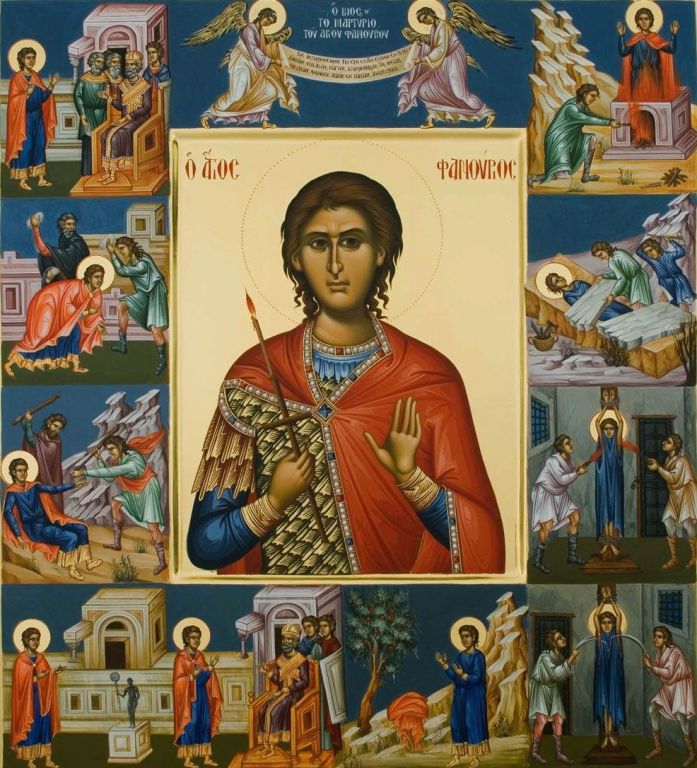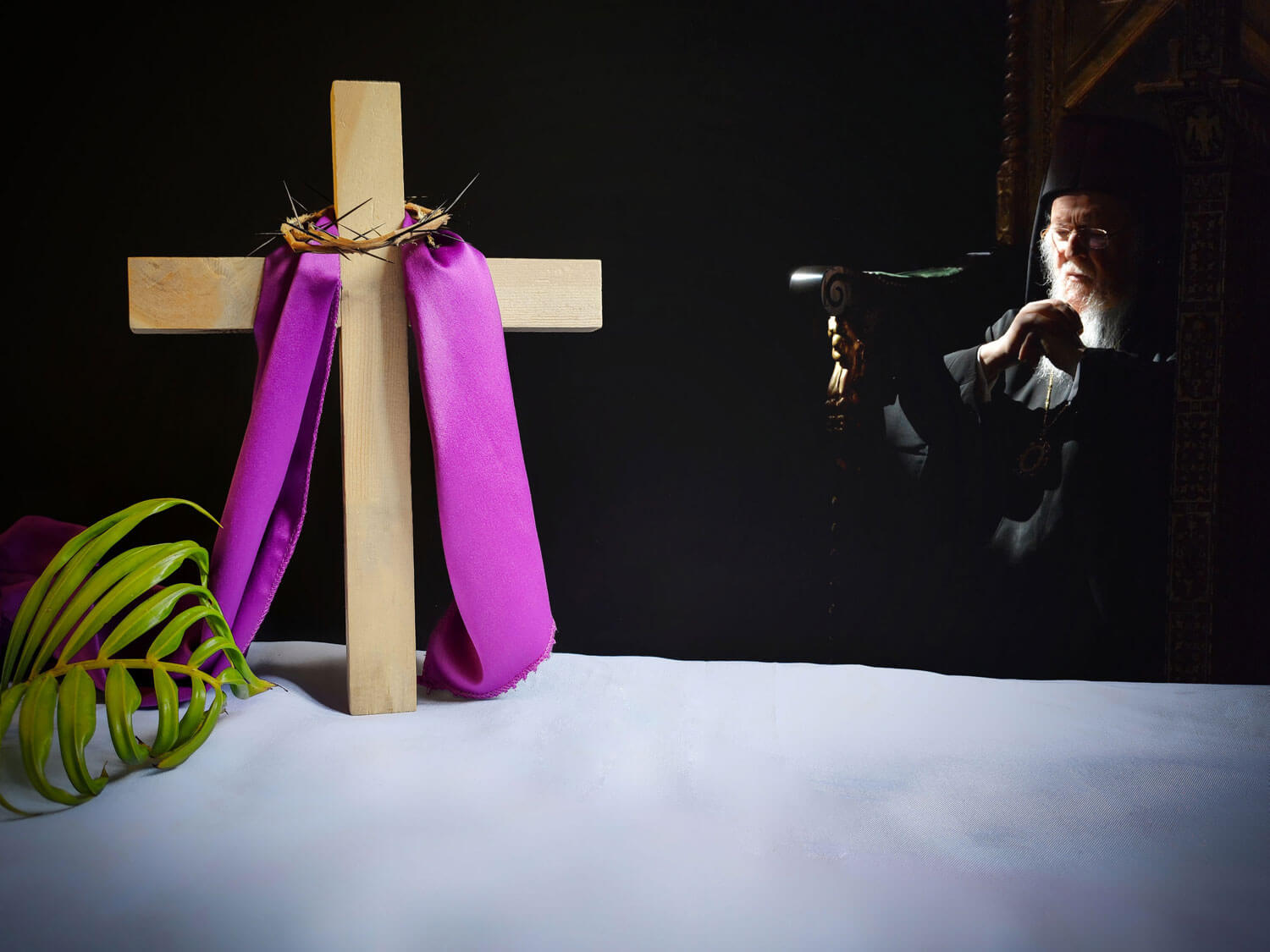Saint Fanourios is without doubt an important and holy youthful figure, who stands out in a particular way among the other Saints of Christianity, as he is not only honoured on a single date, but the faithful often make use of the well-known “fanouropita” (Fanourios cake).
Saint Fanourios, who lived during Roman times, went up bravely against the idolatric world, for the Christian spirit of this man of God did not allow him to deny his unquestionably virtuous principles. Thus, the 12 tortures that the Saint suffered constitute for us a strong motivation for perseverance and adherence to the moral values of Christianity, to come out victors from the in-cessant struggle of unbelief and injustice of our time. This Saint teaches us with his real sacrifice that even though we do not struggle against Roman soldiers and vile Hagarenes, still we have to confront the more skillfully set traps of materialism and atheism, that attempt en masse to overwhelm the Christian order.
Saint Fanourios also taught us that the crown of a virtuous life is not easily won but only through continuous tests – with boldness, patience and perseverance. Therefore, as true fighters of the faith let us imitate the exemplary and irreproachable life of the Saint, so that we too may be found worthy to honour the Christian name we bear, as he so fittingly did.
1. General overview of his life.
Nothing certain is known concerning the lineage and the life of Saint Fanourios because all the information about his life was lost during turbulent times.
The only information we have concerning the Saint is the discovery of his icon, around 1500 AD according to the Synaxarion, or according to other sources around 1355-1369 AD.
2. The discovery of the icon
Let us return to the past, when the Hagarenes (i.e. Muslims) ruled Rhodes and had decided to rebuild the wall of the city, which they so barbarically demolished and leveled a few years previously.
They started to send workers outside the south part of the citadel to gather stones from the semi-ruined houses of the inhabitants, to rebuild the new and strong walls of the city. Among the ruins they discovered a most beautiful church which was partially destroyed on one side. Inside they discovered a multitude of icons, which over the course of time the faces of the Saints as well as the inscriptions on them were indistinguishable.
Only one magnificent icon stood apart from the rest, one that time did not affect, which depicted a youth dressed as a soldier. The Metropolitan of Rhodes, Nilus, went immediately to the site and clearly read the name of the Saint, Fanourios. The Metropolitan, moved by the appearance of the saint, saw that he was dressed as a Roman Soldier, holding a cross in his left hand and a lit candle in his right. Around the icon the iconographer had also painted the twelve depictions of the martyrdom that the saint had suffered, clearly telling his life.
These depictions are as follows:
1. The Saint is present in front of the Roman magistrate, standing and looking like he is boldly testifying and defending his Christian faith.
2. Here the soldiers are intervening and striking Fanourios’ head and the mouth with stones to force him to succumb and deny the Lord.
3. The soldiers have thus far become enraged by the persistence of Fanourios, throwing him to the ground and beating him mercilessly with sticks and clubs to break his steadfast resistance.
4. Fanourios is in jail and is being tortured in a most abominable way. He appears totally naked and the surrounding soldiers are tearing his flesh with sharp metal instruments. The Saint is silently enduring his frightful martyrdom.
5. Fanourios is back in jail praying to God to strengthen him to the end of his tortures.
6. The Saint is again brought before the Roman magistrate to give a defense for his posi-tion. By the peaceful expression on his face it appears that neither the tortures he suf-fered nor the future threats of the tyrant can shake his faith, and thus being undeterred he is waiting for further tortures.
7. The torturers of Fanourios with rage and cruelty are burning his naked body with lit torches, thus showing his insuperable sacrifice for the Crucified One. The Saint wins again with his indomitable will and fortitude for the Lord.
8. Here his savage torturers are making use of mechanical means to achieve the worse of his tortures. They have tied the Saint on a press which crushes his bones when rotated. He is suffering without grumbling, but on his beautiful face there is an inexpressible exul-tation since he is suffering for the sake of the Lord.
9. Fanourios is cast into a pit to become prey to wild beasts and his torturers are watching from above to witness his end. The beasts, however, are totally docile through the grace of God and silently surround him like lambs to enjoy his magnificent company.
10. The torturers were not satisfied by the latest result so they removed him from the hole and are crushing him under a huge rock, convinced that they will finish him off. However, even this time they do not succeed.
11. The scene presents the Saint in front of an altar, where the torturers are urging him to sacrifice, placing burning coal in his hands. Fanourios also passes this test victoriously and a devil in the form of a dragon is shown flying in the air and crying over its failure.
12. The last scene is the end of his martyrdom, with Fanourios being cast into a large furnace standing on a stool and surrounded by flames and smoke. The Saint seems to be praying intently to God, without complaining or grumbling, and thus unwavering and without giving in, he flew to heaven, full of contentment for all the tortures he had suffered for the sake of the Lord.
3. The Erection of the Church.
The then Metropolitan of the island, Nilus, after carefully studying the icon that was found, pronounced that Fanourios was one of the most significant great martyrs of our Faith. He immediately dispatched a delegation to the ruler of the island and to ask him for a permit to erect a church. However, when the ruler refused the Metropolitan himself went to Constantinople and managed to obtain from the Sultan the permit he sought. He soon returned to Rhodes and built the church exactly on its old spot, outside the walls. The Church survives to this day and is a sacred shrine for all Christians.
The Church celebrates the memory of the Holy Martyr on August 27.





